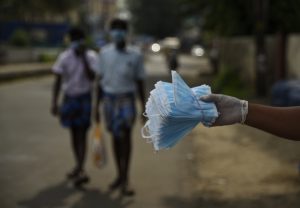India’s southwestern state of Kerala is known for its “backwaters,” a stunning network of rivers and lakes that runs through acres of coconut palm trees. These days, however, the state’s famous houseboats are empty of tourists – instead, they are home to coronavirus patients.
When the virus arrived in India, local Keralan authorities quickly partnered with tour companies to requisition boats to provide a safe and secluded place for those infected to recover. This is just one example of the many creative measures the state government has taken. A highly competent and well-resourced public sector, aggressive testing, and socio-economic measures to care for the poor and vulnerable has made the “Kerala model” one of the best in India – if not the world – in combating COVID-19.
Much of this is attributable to Kerala’s health minister, K.K. Shailaja, who stands among the ranks of women leaders containing the pandemic better than the rest. A former science teacher, Shailaja has been nicknamed the “Coronavirus Slayer” by the Indian media.
India’s first coronavirus case was discovered in Kerala in January, and at one point the state even had the highest rate of infection in the country. But while the Indian government was still debating a nation-wide response, K.K. Shailaja had already put into place an efficient strategy at the state level. By January, the state had started airport screenings and tracing to isolate persons suspected of being exposed to the virus. By February, she established protocols for a response team to coordinate with public officials across the state. Three months later, only four of 482 diagnosed patients have died and more than half have recovered – the best record in the country. Those cured include a 93-year-old man and his 85-year-old wife.
By early March, Kerala had imposed a partial lockdown, banned large gatherings, and advised against visiting places of worship. Tracking and isolation of exposed persons continued on an almost epic scale, despite the challenges of a densely populated state that is home to 34 million people. By the end of March, some 162,000 people were isolating across Kerala, with local authorities even supplying some of those in quarantine with groceries as incentive to stay at home.
Kerala’s “army” of healthcare workers and first-class medical care has played a huge role in containing the virus. The state led the way on testing – by early April, Kerala had conducted some 15,000 tests, compared to only some 8,000 in the larger state of Andhra Pradesh. The state also spearheaded the use of rapid testing kits and walk-in clinics in India.
Kerala’s excellent healthcare system is no accident. The state has a long tradition of left-wing activism, decentralized governance and was home to one of the world’s first democratically elected communist governments in 1957. Decades of generous spending on the public sector has made it the state with the highest literacy rate (94 percent) and lowest child and maternal mortality rates in the country. Kerala’s highly skilled medial staff are often poached by hospitals in wealthier countries.
In addition, the Kerala government announced a $2.6 billion coronavirus relief package days before the national lockdown set in – the first state in the country to do so. This involved delivering food to schoolchildren reliant on free lunches, setting up community kitchens to feed the public, and providing provisions through ration shops. Kerala’s Chief Minister Pinarayi Vijayan even convinced internet service providers to boost network capacity to support the millions working from home.
In Kerala, the state government set up thousands of camps to house returning migrant workers, and put protections in place so that workers who lost their jobs due to the virus could not be ousted from where they stay. Frequent health inspections have prevented mass outbreaks among migrant workers. This is perhaps not surprising for a state that insists on using the phrase “guest workers” to remove some of the stigma associated with migrant labor.
Daily wage earners and migrant workers elsewhere in India were not as fortunate. The sudden national lockdown on March 24 had a devastating toll on the poorest across the country as work, food supplies and other necessities dried up without notice. Thousands of low wage migrant workers had no option but to walk hundreds of miles back to their home states, which led to dozens of deaths. Others have fallen prey to police abuse for violating curfews. Health care systems have been overwhelmed and there are desperate shortages of life-saving equipment.
Another important dimension of Kerala’s success story is community engagement, in particular in rallying support for health workers. This is essential to building the trust needed for strategies like testing, contact tracing, and isolation to work. NGOs have also played their part – one example is Pallium India, a local group that advocates for holistic patient care. Its chair, Dr. M.R. Rajagopal, is full of pride for the state’s response, but also cautions that there are challenges ahead: “We should not aim just to prevent community spread and deaths, but also to reduce COVID-related suffering. This includes breathlessness, delirium and agitation, and the mental health consequences of the sudden loss of loved ones in an instant, never to be seen again.”
For now, Kerala stands as a global example on how to tackle the virus in an efficient, lawful and humane manner. Many world leaders should take note.
Binaifer Nowrojee is regional director for Asia Pacific for the Open Society Foundations.

































